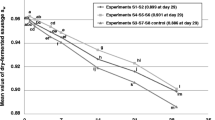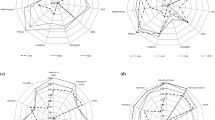Abstract
Cheese powder addition to dry-fermented sausage was assessed as a tool to boost flavour and reduce salt content. The effect of different type of cheese powders (mixtures of different types of hard cheeses) and salt content (standard and 40% reduction) on physicochemical and sensory characteristics of dry-fermented sausages was evaluated. Both salt and cheese powder had an effect on physicochemical parameters, whereas only salt had an effect on the sensory attributes of fermented sausages (saltiness, sourness, flavour intensity and complexity). The increase of flavour intensity and sourness when cheese powder is added might confirm the cheese powder potential as a flavour enhancer. Several γ-glutamyl dipeptides were identified in dry-fermented sausages and cheese powders. The presence of γ-glutamyl dipeptides in dry-fermented sausages and cheese powders suggest they might influence the kokumi perception.

Similar content being viewed by others
Availability of data and material
Data are available but material is not anymore.
References
WHO (2015) The European health report 2015. Targets and beyond—reaching new frontiers in evidence. WHO, Copenhagen
WHO (2014) Global status report on noncommunicable diseases 2014. Switzerland, Geneva
Partearroyo T, Samaniego-Vaesken ML, Ruiz E et al (2019) Sodium intake from foods exceeds recommended limits in the Spanish population: the ANIBES study. Nutrients 11:2451. https://doi.org/10.3390/nu11102451
Inguglia ES, Zhang Z, Tiwari BK et al (2017) Salt reduction strategies in processed meat products—a review. Trends Food Sci Technol 59:70–78. https://doi.org/10.1016/j.tifs.2016.10.016
Gimeno O, Astiasarán I, Bello J (1999) Influence of partial replacement of NaCl with KCl and CaCl2 on texture and color of dry fermented sausages. J Agric Food Chem 47:873–877. https://doi.org/10.1021/jf980597q
Zanardi E, Ghidini S, Conter M, Ianieri A (2010) Mineral composition of Italian salami and effect of NaCl partial replacement on compositional, physico-chemical and sensory parameters. Meat Sci 86:742–747. https://doi.org/10.1016/j.meatsci.2010.06.015
dos Santos BA, Campagnol PCB, Morgano MA, Pollonio MAR (2014) Monosodium glutamate, disodium inosinate, disodium guanylate, lysine and taurine improve the sensory quality of fermented cooked sausages with 50% and 75% replacement of NaCl with KCl. Meat Sci 96:509–513. https://doi.org/10.1016/j.meatsci.2013.08.024
Delgado-Pando G, Allen P, Kerry JP et al (2019) Optimising the acceptability of reduced-salt ham with flavourings using a mixture design. Meat Sci 156:1–10. https://doi.org/10.1016/j.meatsci.2019.05.010
Guàrdia MD, Guerrero L, Gelabert J et al (2006) Consumer attitude towards sodium reduction in meat products and acceptability of fermented sausages with reduced sodium content. Meat Sci 73:484–490. https://doi.org/10.1016/j.meatsci.2006.01.009
Mora-Gallego H, Guàrdia MD, Serra X et al (2016) Sensory characterisation and consumer acceptability of potassium chloride and sunflower oil addition in small-caliber non-acid fermented sausages with a reduced content of sodium chloride and fat. Meat Sci 112:9–15. https://doi.org/10.1016/j.meatsci.2015.10.008
Aaslyng MD, Vestergaard C, Koch AG (2014) The effect of salt reduction on sensory quality and microbial growth in hotdog sausages, bacon, ham and salami. Meat Sci 96:47–55. https://doi.org/10.1016/j.meatsci.2013.06.004
Varming C, Andersen LT, Petersen MA, Ardö Y (2013) Flavour compounds and sensory characteristics of cheese powders made from matured cheeses. Int Dairy J 30:19–28. https://doi.org/10.1016/j.idairyj.2012.11.002
Toelstede S, Dunkel A, Hofmann T (2009) A series of kokumi peptides impart the long-lasting mouthfulness of matured Gouda cheese. J Agric Food Chem 57:1440–1448. https://doi.org/10.1021/jf803376d
Ueda Y, Sakaguchi M, Hirayama K et al (1990) Characteristic flavor constituents in water extract of garlic. Agric Biol Chem. https://doi.org/10.1271/bbb1961.54.163
Kuroda M, Kato Y, Yamazaki J et al (2013) Determination and quantification of the kokumi peptide, γ-glutamyl-valyl-glycine, in commercial soy sauces. Food Chem 141:823–828. https://doi.org/10.1016/j.foodchem.2013.03.070
Miyamura N, Iida Y, Kuroda M et al (2015) Determination and quantification of kokumi peptide, γ-glutamyl-valyl-glycine, in brewed alcoholic beverages. J Biosci Bioeng 120:311–314. https://doi.org/10.1016/j.jbiosc.2015.01.018
Yang J, Bai W, Zeng X, Cui C (2019) Gamma glutamyl peptides: the food source, enzymatic synthesis, kokumi-active and the potential functional properties—a review. Trends Food Sci Technol 91:339–346. https://doi.org/10.1016/j.tifs.2019.07.022
Xiang C, Ruiz-Carrascal J, Petersen MA, Karlsson AH (2017) Cheese powder as an ingredient in emulsion sausages: effect on sensory properties and volatile compounds. Meat Sci 130:1–6. https://doi.org/10.1016/j.meatsci.2017.03.009
Hillmann H, Hofmann T (2016) Quantitation of key tastants and re-engineering the taste of Parmesan cheese. J Agric Food Chem 64:1794–1805. https://doi.org/10.1021/acs.jafc.6b00112
AOAC (2007) Official methods of analysis, 18th edn. Association of Official Analytical Chemists, Arlington
Liukkonen-Lilja H, Wallin H (2004) No 178 chloride (salt). Determination in foods by potentiometric titration. NMKL methods. NMLK, Helsinki, pp 1–5
Bourne MC (1978) Texture profile analysis. Food Technol 32:62–66
Perez-Palacios T, Barroso MA, Ruiz J, Antequera T (2015) A rapid and accurate extraction procedure for analysing free amino acids in meat samples by GC-MS. Int J Anal Chem 2015:209214. https://doi.org/10.1155/2015/209214
ASTM (1981) American Society for Testing and materials. Guide-lines for the selection and training of sensor and panel members. ASTM STP 758, Philadelphia
Macfie HJ, Bratchell N, Greenhoff K, Vallis LV (1989) Designs to balance the effect of order of presentation and first-order carry-over effects in hall tests. J Sens Stud 4:129–148. https://doi.org/10.1111/j.1745-459X.1989.tb00463.x
Kameník J, Saláková A, Vyskočilová V et al (2017) Salt, sodium chloride or sodium? Content and relationship with chemical, instrumental and sensory attributes in cooked meat products. Meat Sci 131:196–202. https://doi.org/10.1016/j.meatsci.2017.05.010
Huff-Lonergan E, Lonergan SM (2005) Mechanisms of water-holding capacity of meat: the role of postmortem biochemical and structural changes. Meat Sci 71:194–204. https://doi.org/10.1016/j.meatsci.2005.04.022
Alejandre M, Poyato C, Ansorena D, Astiasarán I (2016) Linseed oil gelled emulsion: a successful fat replacer in dry fermented sausages. Meat Sci 121:107–113. https://doi.org/10.1016/j.meatsci.2016.05.010
Astiasaran I, Villanueva R, Bello J (1990) Analysis of proteolysis and protein insolubility during the manufacture of some varieties of dry sausage. Meat Sci 28:111–117. https://doi.org/10.1016/0309-1740(90)90035-5
Kęska P, Stadnik J, Wójciak KM, Neffe-Skocińska K (2020) Physico-chemical and proteolytic changes during cold storage of dry-cured pork loins with probiotic strains of LAB. Int J Food Sci Technol 55:1069–1079. https://doi.org/10.1111/ijfs.14252
Hu Y, Zhang L, Zhang H et al (2020) Physicochemical properties and flavour profile of fermented dry sausages with a reduction of sodium chloride. LWT 124:109061. https://doi.org/10.1016/j.lwt.2020.109061
Fox PF, Guinee TP, Cogan TM, McSweeney PLH (2017) Cheese as an ingredient. In: Fox PF, Guinee TP, Cogan TM, McSweeney PLH (eds) Fundamentals of cheese science. Springer, Boston, pp 629–679
Corral S, Salvador A, Flores M (2013) Salt reduction in slow fermented sausages affects the generation of aroma active compounds. Meat Sci 93:776–785. https://doi.org/10.1016/j.meatsci.2012.11.040
Tobin BD, O’Sullivan MG, Hamill RM, Kerry JP (2013) The impact of salt and fat level variation on the physiochemical properties and sensory quality of pork breakfast sausages. Meat Sci 93:145–152. https://doi.org/10.1016/j.meatsci.2012.08.008
Lilic S, Brankovic Lazic I, Karan D, Babic J et al (2017) Effect of sodium chloride reduction in dry fermented sausages on sensory parameters and instrumentally measured colour. Meat Technol 57:22–26
Çarkcioğlu E, Rosenthal AJ, Candoğan K (2016) Rheological and textural properties of sodium reduced salt soluble myofibrillar protein gels containing sodium tri-polyphosphate. J Texture Stud 47:181–187. https://doi.org/10.1111/jtxs.12169
Lorenzo JM, Fonseca S, Gómez M, Domínguez R (2015) Influence of the salting time on physico-chemical parameters, lipolysis and proteolysis of dry-cured foal “cecina.” LWT Food Sci Technol 60:332–338. https://doi.org/10.1016/j.lwt.2014.07.023
Laranjo M, Agulheiro-Santos AC, Potes ME et al (2015) Effects of genotype, salt content and calibre on quality of traditional dry-fermented sausages. Food Control 56:119–127. https://doi.org/10.1016/j.foodcont.2015.03.018
Ruusunen M, Puolanne E (2005) Reducing sodium intake from meat products. Meat Sci 70:531–541. https://doi.org/10.1016/j.meatsci.2004.07.016
Kuroda M, Miyamura N (2019) Effect of a kokumi peptide, γ-glutamyl-valyl-glycine, on the sensory characteristics of foods bt-koku in food science and physiology: recent research on a key concept in palatability. In: Kuroda M (ed) Nishimura T. Springer, Singapore, pp 85–133
Toelstede S, Hofmann T (2009) Kokumi-active glutamyl peptides in cheeses and their biogeneration by Penicillium roquefortii. J Agric Food Chem. https://doi.org/10.1021/jf900280j
Hillmann H, Behr J, Ehrmann MA et al (2016) Formation of kokumi-enhancing γ-glutamyl dipeptides in Parmesan cheese by means of γ-glutamyltransferase activity and stable isotope double-labeling studies. J Agric Food Chem 64:1784–1793. https://doi.org/10.1021/acs.jafc.6b00113
Sforza S, Galaverna G, Schivazappa C et al (2006) Effect of extended aging of Parma dry-cured ham on the content of oligopeptides and free amino acids. J Agric Food Chem 54:9422–9429. https://doi.org/10.1021/jf061312+
Paolella S, Prandi B, Falavigna C et al (2018) Occurrence of non-proteolytic amino acyl derivatives in dry-cured ham. Food Res Int 114:38–46. https://doi.org/10.1016/j.foodres.2018.07.057
Dang Y, Gao X, Ma F, Wu X (2015) Comparison of umami taste peptides in water-soluble extractions of Jinhua and Parma hams. LWT Food Sci Technol 60:1179–1186. https://doi.org/10.1016/j.lwt.2014.09.014
Harrison AG (2003) Fragmentation reactions of protonated peptides containing glutamine or glutamic acid. J Mass Spectrom 38:174–187. https://doi.org/10.1002/jms.427
Dunkel A, Koster J, Hofmann T (2007) Molecular and sensory characterization of gamma-glutamyl peptides as key contributors to the kokumi taste of edible beans (Phaseolus vulgaris L.). J Agric Food Chem 55:6712–6719. https://doi.org/10.1021/jf071276u
Suzuki H, Kajimoto Y, Kumagai H (2002) Improvement of the bitter taste of amino acids through the transpeptidation reaction of bacterial gamma-glutamyltranspeptidase. J Agric Food Chem 50:313–318. https://doi.org/10.1021/jf010726u
Roudot-Algaron F, Kerhoas L, Le Bars D et al (2017) Isolation of gamma-glutamyl peptides from Comté cheese. J Dairy Sci 77:1161–1166. https://doi.org/10.3168/jds.S0022-0302(94)77053-3
Srinivasan P, Annapure US (2000) Mini-papad containing cheese powder–a novelty snack food. Int J Food Sci Nutr 51:175
Acknowledgements
The valuable cooperation formulating the study design and the sensory analysis of Inger Hansen, Sárah Prehn, Søren Eybye, and Danai Tziouri from Lactosan is acknowledged. The panellists at Lactosan A/S are acknowledged for their participation in training and sensory tests sessions. Jorge Ruiz-Carrascal thanks Norma & Frode S. Foundation for their financial support. The valuable cooperation of Linda de Sparra Terkelsen, Senior lab technician, in sampling and laboratory analysis is also acknowledged.
Funding
This research was supported by Lactosan A/S (Grant Number 50552300) in Ringe, Denmark.
Author information
Authors and Affiliations
Contributions
AAM: sample preparation, conducting hands-on experiments, data collection, analysis of data, manuscript draft writing; CDG: conducting hands-on experiment of peptide quantification, data collection and manuscript review; RL: conceive and design of the experiments of peptide quantification and manuscript review; JRC: conceive and design of the experiments, guidance and supervision of experiments and data analysis and manuscript review.
Corresponding author
Ethics declarations
Conflict of interest
On behalf of all authors, the corresponding author states that there is no conflict of interest.
Additional information
Publisher's Note
Springer Nature remains neutral with regard to jurisdictional claims in published maps and institutional affiliations.
Rights and permissions
About this article
Cite this article
Araya-Morice, A., De Gobba, C., Lametsch, R. et al. Effect of the addition of cheese powder and salt content on sensory profile, physicochemical properties and γ-glutamyl kokumi peptides content in dry fermented sausages. Eur Food Res Technol 247, 2027–2037 (2021). https://doi.org/10.1007/s00217-021-03769-z
Received:
Revised:
Accepted:
Published:
Issue Date:
DOI: https://doi.org/10.1007/s00217-021-03769-z




